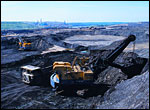It used to be that oil came from a hole drilled in the ground. But as oil has become more scarce, the ways of getting at it have become more numerous — so much so that it’s getting hard to keep track. Oil sands, shale oil, oil shale: These are all different sources of oil. And if you can’t keep them straight, well, rest assured the oil industry will.
The Council on Foreign Relations’ Michael Levi argues that it’s oil shale that might be the extraction point to watch in the coming years:
“Oil shale” is basically rock that contains kerogen. You melt it (loosely speaking) to produce oil. It was a hot prospect in the late 1970s, but when the price of oil crashed, so did development.
Developing oil shale requires huge investments and hasn’t made economic sense yet. But at a hearing last week, a former Bush administration official was hitting the Obama administration for limiting oil shale development options.
If the industry does start to develop oil shale, expect a host of environmental issues. According to Levi:
[Oil shale] is also hugely controversial: the local environmental impacts of shale oil development are often compared to those from Canadian oil sands extraction … Shale oil development also puts big demands on water resources, which (at best) would need to be carefully managed. And, of course, development of U.S. oil shale would increase greenhouse gas emissions, insofar as it didn’t displace other similarly energy-intensive oil.
There aren’t huge projects going after this source of oil yet. But there very well could be in the future. So now’s probably the time to start learning the difference between shale oil and oil shale.



